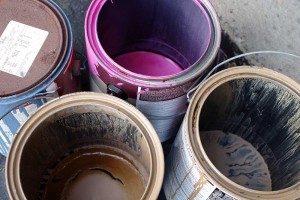A few years ago, I walked into the newly renovated, partially furnished apartment I had just rented, and thought, “Neat, it’s got that ‘new car smell’ we all know and love.”
It wasn’t until a friend came over a couple days later and forced me to open all the windows that I learned that the new-car smell was actually the scent of formaldehyde particles being released (or “off-gassing”) into the air from the pressed-wood wardrobe standing in the hallway.
Formaldehyde? As in, the stuff that fills up those creepy jars of preserved specimens?
Yep. Turns out, pressed wood, particleboard, and plywood all use glues that contain formaldehyde, a known carcinogen. But it doesn’t end there — many paints and carpets commonly found in people’s homes also contain formaldehyde.
Unlike Sharpies, not every off-gassing product has a strongly noticeable scent (which you may love or loathe), and you may not experience any immediate effects on your health. But just like outdoor pollution, high levels of indoor pollution can affect your health over time.
The U.S. Environmental Protection Agency (EPA) has stated that our indoor environment can be two to five times more polluted than our outdoor environment. Considering that Americans spend a whopping 90% of the day indoors, what’s a new homeowner to do to maintain an indoor air quality that is as healthy as possible?
Look for low-VOC goods
When you purchase new furniture, paints, carpet, wallpaper, cleaning products, and even shower curtains, try to make sure they are made from low-VOC or zero-VOC materials. VOC stands for “volatile organic compound.” Low-VOC or zero-VOC materials have low or no rates of emitting toxic pollutants into the air.
Especially if anyone in your family is chemically sensitive, suffers from asthma, or is prone to allergies, investing in low-VOC or zero-VOC products is pretty important.
Hunt down allergens
Go through your home to locate the possible sources of allergens and toxic pollutants, especially the products you come into contact with the most.
Of course, the best way to start removing allergens like mold and dust is to do a thorough housecleaning — that includes decluttering your home.
Pay attention to all surfaces
If you have young children who play on the floor, look for zero-VOC carpets or natural rugs made from cotton, silk, or wool. You can also stay away from carpets entirely by investing in ceramic tiles or bamboo or cork flooring.
Watch out for lead
If you live in an older home, make sure you consider the presence of lead paint. Even low levels of lead in a child’s system can lead to serious health problems. The EPA has comprehensive resources available on its website.
Look for solid pieces
Choose solid wood furniture, which you can sometimes find more cheaply at a vintage shop or garage sale. However, if you can’t let go of your beloved IKEA bookcase, take comfort in the fact that the company claims its products contain very low levels of formaldehyde.
Choose green cleaners
Buy household cleaning products that are made with natural ingredients. Or do it the old-fashioned way (and save some cash!) by making your own cleaning products. For example, nothing beats a simple vinegar-and-water solution for cleaning windows and mirrors.
Control indoor humidity
If you control the amount of moisture inside your home, you can greatly reduce the chances of mold growth. Using a dehumidifier will help reduce moisture. Mold in the home can affect throat and eye irritation, as well as exacerbate asthma.
Let your rooms breathe
Open your windows! Ventilation helps sweep away some toxic fumes (including tobacco smoke) and bring in much-needed fresh air to circulate around the house. Houseplants can also help oxygenate a room — but you’ll need to invest in several large leafy greens to make an impact. NASA’s clean air study ranked the most beneficial plants in a handy cheat sheet.


